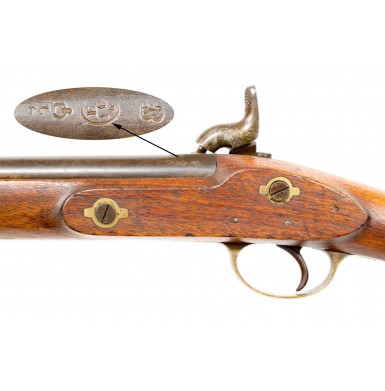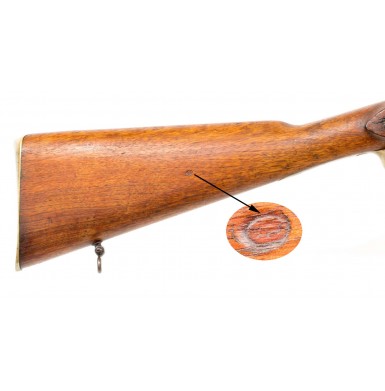British Military Pattern 1853 Type II Artillery Carbine
- Product Code: FLA-3570-SOLD
- Availability: Out Of Stock
-
$2,795.00
The Pattern 1853 “Enfield” family of British military percussion long arms that started with the Pattern 1853 “Enfield” Rifle Musket gave rise to a variety of shorter, long arms for use by specialty troops. These included an entire series of 33” barreled “short rifles”, the 21” barreled Pattern 1856 Cavalry Carbine with its captive ramrod and the 24” barreled Artillery Carbine, which was produced in three variations: Pattern 1853, Pattern 1853 Type II (aka Pattern 1858) and Pattern 1861.
The Artillery Carbines were intended for troops that might have the need for a long arm (rather than a handgun) but did not need to be encumbered with the weight and length of either the P1853 rifle musket (“long Enfield”) or P1856, P1858 or P1860 “short rifles”. The Enfield Artillery carbine was the functional equivalent of the M1 carbine during the mid-19thcentury for the British military. As these guns were only intended for use by specialty troops in the British Army, they were produced in very small numbers and as result they are not commonly encountered today.
The Pattern 1853 Artillery Carbine was adopted by the British military in January 1853, with the initial contracts being let for it in October of that year. Like the rifle musket that it was patterned on, it was a .577 caliber, muzzle loading, percussion ignition long arm. The gun was brass mounted and was 40” in overall length. The 24” barrel was rifled with three grooves, making one turn in 78”, and had a bayonet lug mounted on the right side near the muzzle. The bayonet was a semi-Yataghan saber bayonet, of the same basic design as that used on the P-1856/58/60/61 pattern short rifles. The bayonet for the Artillery carbine was the only one in British service (at that time) to utilize a metal scabbard, instead of the more commonly encountered steel mounted leather scabbard. As initially produced, the carbine had a simple three-leaf rear sight, which was graduated to 100, 200 and 300 yards. A sling swivel was mounted on the upper of the two barrel bands and one was screwed into the toe of the stock, to the rear of the triggerguard tang. The first pattern carbines utilized a semi-tulip head ramrod, similar to that found on Type I and early Type II P1853 Rifle Muskets, while later production guns used the more commonly encountered jag head ramrod typically associated with the Enfield series of arms.
The primary pattern design changes to the artillery carbine occurred in 1858 and 1861. The new Pattern 1853 Type II Artillery Carbine (or Pattern 1858) adopted the progressive depth rifling system that had been used successfully on the P1853 Rifle Musket. At this time the ramrod was officially changed to the jag head pattern that had been adopted for the P1853 Rifle Musket as well. There were some other minor structural changes, including the removal of the short guide key on the bayonet lug, a design change in the rammer retention spoon, as well a design change to the brass nose cap; all of which made the gun more like the then current production P1853 Type III Rifle Musket. The final major innovations took the form of the Pattern 1861 Artillery Carbine. This gun adopted the 5-groove rifling system, which had become standard on all short rifles in 1860 and also adopted a new rear sight, graduated to 600 yards. The rear sight was now visually very similar to the rifle and rifle musket rear sights, with a long base and ladder with an elevating bar. The use of the rounded Baddeley Patent barrel band was also adopted for the lower band of the P1861 carbine.
Like many of the British military long arms produced during the mid-19thcentury, it was sometimes necessary to source the weapons from makers other than the usual group of London and Birmingham contracts to the War Department. The first choice for non-British makers was usually the gunmaking center of Liège, Belgium. The British had relied upon the Belgian gun trade to supply additional arms in cases of national emergency as far back as the early 18thcentury and relied upon the Belgians heavily during the Napoleonic Wars and Crimean War, as British makers could simply not keep up with the demands of the British army. In the desperate circumstances of the Crimean War, the British even turned to gunmakers of Solingen (Prussia), as well as France and the United States.
The Pattern 1853 Type II “Enfield” Artillery Carbine offered here is in about FINE overall condition. It is one of the Belgian contract arms that was likely initially ordered during the Crimean War (1853-1856) but was delivered after the conflict was over. The gun is clearly marked on the lock, forward of the hammer with the date 1857, a year after the end of the conflict. A British royal crown is stamped to the rear of the hammer at the tail of the lock plate. The upper left hand quadrant of the breech is stamped with a pair of Liège proof marks, as well as a British military inspection proof. An additional series of British military inspection marks are present on the top of the nocksform, including a small Crown/(Broad Arrow) mark, two additional inspection marks and a large Lin an oval that is stamped partially on both the nocksform and the tang. The Liège Perron mark is present on the barrel, forward of the bolster.
The gun is 100% complete, correct and original, which is quite rare to encounter with this pattern of carbine. The gun retains an original, period and correct multi-leaf rear sight, its original lower sling swivel (screwed into the toe of the stock) as well as the original upper sling swivel. Even both of the small screw-retaining doughnuts on the barrel band tension screws are still in place, which is rather uncommon. The original saber bayonet lug, with the bayonet mating mark 11 is in place near the muzzle and the original ramrod is in place, which is full-length with good threads at the end. While no “snap cap” (nipple protector) is present, it appears that this Belgian contract carbine was not produced with the usual small attachment stud, forward of the triggerguard, where the split ring would secure the snap cap. Unlike British made contract arms, this Belgian made gun does not have a plethora of contractor names, inspection marks and assembly marks throughout. A simple punch dot serves as the assembly mating mark and only one contractor name is present, I DUCE, which is found on the reverse of the two barrel bands. While the bottom of the barrel does show a couple of British military inspection marks and some Belgian marks as well, it is not as heavily marked as an English made gun would be.
As previously noted, the overall condition of the gun is about FINE condition. The action of the lock works perfectly on all positions and remains quite crisp and tight. The lock has a mottled brownish patina over a smooth pewter base color. The lock does show some lightly scattered surface oxidation and minor pinpricking forward of the hammer, with a small patch of more moderate surface roughness at the tail of the lock. The barrel retains about 30%+ of its original blued finish, which has faded, dulled and worn. The metal is mostly smooth, with a slightly mottled patina of dull pewter gray and oxidized brown where the finish is worn. There are some scattered patches of surface oxidation and some minor roughness here and there, but nothing really worth mentioning beyond the patch at the tail of the lock. The bore of the carbine rates about FINE. It is mostly bright and retains crisp rifling throughout. There is some scattered minor oxidation present and some surface crust in the last two to three inches nearest the muzzle, but this would likely clean out, leaving the bore closer to excellent. The brass furniture has a lovely, untouched, medium ocher patina that is very attractive. The stock is in about VERY FINE overall condition and is solid, complete and full length with no breaks, cracks or repairs. The wood is very crisp, and the surface of the stock retains some traces of the “feathery” texture found on guns in “like new” condition. The edges remain quite sharp throughout and the wood shows no signs of having been sanded. The wood does show some scattered light bumps, dings and mars from handling and use, but shows no abuse or actual damage. The only condition issue worth mentioning is some very minor surface wood loss to the rear of the lock mortise, apparently the result of improper lock removal at some point in time. A pair of small oval marks are present in the wood, one on the obverse of the butt and one at the wrist. These appear to have been small Belgian maker’s marks, but neither remains legible due to wear.
Overall this is a really very attractive and rather high condition example of one of the rarer British Military long arms of the mid-19thcentury. These guns do not appear for sale very often. When they do, they are often missing some of the small parts like the sight leaves or the thread protectors for the barrel band tension screws. This example is very crisp, mechanically fine, has a very nice bore and retains some of the original blued finish. Considering the overall rarity of these guns when compared to the much more plentiful Pattern 1853 Enfield Rifle Muskets and the numerous variants of Enfield short rifles on the market, this is a great chance to acquire a fairly high condition example for a very reasonable price. This will be a wonderful addition to your collection of 19thcentury British military arms and would even make a wonderful black powder shooter, based upon the condition of the bore.
SOLD
Tags: British, Military, Pattern, 1853, Type, II, Artillery, Carbine















